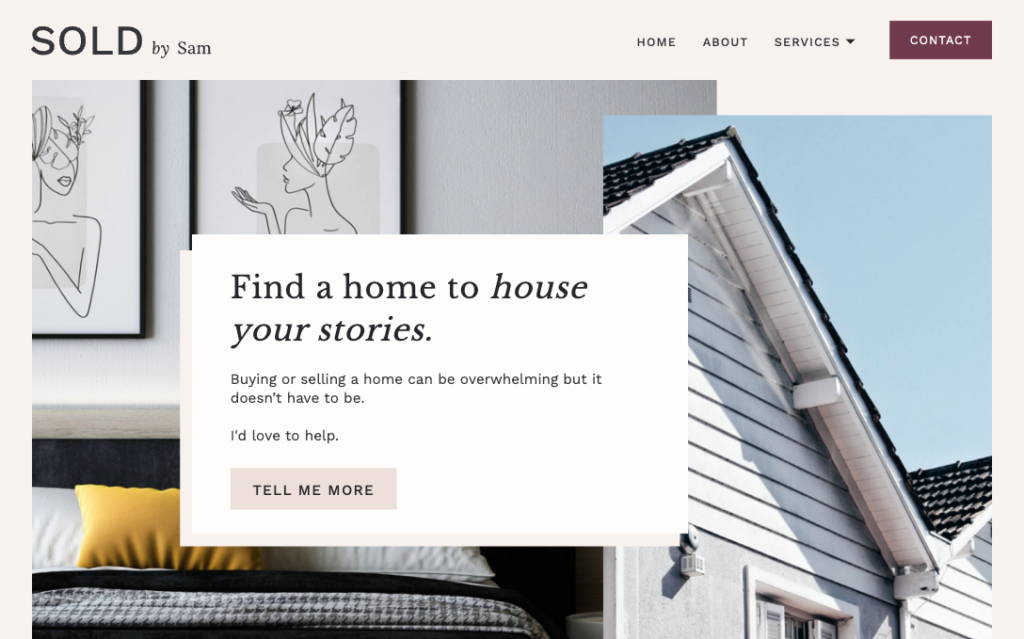How Storytelling Can Uplevel Your Business
You’ve heard it before—people buy from people.
But what does that really mean?
It means if people don’t feel connected with the product or service, whomp whomp. Over to the next one.
And here’s the thing: you got 50 milliseconds or less to make an impression and keep people on the page (CXL).
How on earth do we achieve this?
Through storytelling.
In this post, you’ll learn about three entrepreneurs who re-introduced their businesses and ministries through the (lost) art of storytelling.
By the end of this post, you’ll have three ways to weave storytelling into your website but also in your business in general.

1. Meet your audience where they’re at by collecting data.
“You’ve sold me to me!”
My first web design client, Sam, was a real estate agent.
When we started working together, Sam was just getting her feet wet in the business.
That meant there wasn’t a lot of past customer data for us to sit in and use to craft her website…
…or so we thought.
I listened to the ground, er, went on Google Search and studied the types of questions people typed in about getting a realtor.
And while I was on Google, I read customer reviews of realtors—particularly listening to what they raved about or what they had gripes with.
Taking this “fly-on-the-wall” research, I had a better idea of what Sam’s audience was most likely to feel, think, and do.

From there, we catered it to the type of people she wanted to work with and wove it into her story—why she became a realtor in the first place and what makes her the perfect person to journey with them.
This means you have to be clear with your why, before you even think about what you do and for whom.
If you need help, here’s a free worksheet I created that helps you dig into these questions.

Surprise, they also help you get crystal-clear with your brand!
And a clear brand story helps your web designer (take it from this friendly web designer).
Case in point: when I met up with her at a pho restaurant to present her own website, Sam squealed “I can’t believe it—you’ve sold me to me!”
The takeaway?
Meet your audience where they’re at and reassure them that it is possible to get to where they want to be.
2. When necessary, use words in your story.
Last summer, I got to work with Techie of Tech’s Heavenly Treats.
She had been baking up a storm for nearly a decade.
Techie had a website but it wasn’t picking up half the load it could, and she had been close to burning out on several occasions.
Something needed to change.
When I went to the Menu page, the descriptions of her sweet treats ran across the page. I’m a sweet tooth, but I only knew half of the lingo in the product descriptions.
This seemed to be a trend across the site—information decked the pages but I was more inclined to skim or skip the section altogether.
And I’m not just being mean.
In an article about his book, “Thinking, Fast and Slow”, psychologist Daniel Kahman talks about two modes of thinking: System 1 and System 2.
System 1 is quick and almost automatic, whereas System 2 “allocates attention to the effortful mental activities that demand it”.
In the case of Techie’s website, it was difficult to picture the decadent desserts just by seeing the name and ingredients.
What we needed were photos—but not just any photo that you would pull from Facebook.
We needed photos where the treats popped out.
After a little touch-up, we brought out the natural colours of Techie’s treats.
Now, we were able to pair it with descriptions that resonated with her audience.
As the saying goes—a picture is worth a thousand words. It definitely is the case for product-based business, so make sure your pictures are high quality!
Because if they’re good enough, a picture itself can tell a story or remind you of a good one.
Tip: Once you have a clear brand story, compile a “lookbook” or Pinterest board of how you want your brand to look. Ask yourself—what do you like about these photos? How does it relate to how you want people to remember their experience with you?
3. Weave every interaction into the bigger story—one where your audience victoriously arrives at their dream destination.
This applies whether or not you’re working on the Home page or Contact page.
Help the reader get one step closer to their goal.
This can be as simple as including a line on the Subscribe form of your website, saying something like “Get your weekly dose of copywriting tips so that you’re never out of words to say”.

Source: clayimoo.com
I’m sure you can think of something.
At the heart of it all, you need to know where your audience currently is and where they want to be.
The gap between these two points can be broken up into a series of actions (your call-to-actions).
Stories are powerful because, when done right, they establish a connection with your audience right away.
These tips can help you revamp your website to welcome your people, even when you’re away!
Sign up for emails that remind you of the beauty in the mundane and the humanity in business—so you can apply it to your website, brand, and your overall digital presence.
De-influencing what "building your business" looks like.
the only emails on the internet that talk about the *unglamorous* side to entrepreneurship.